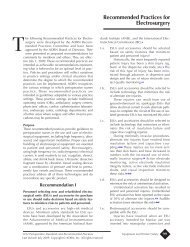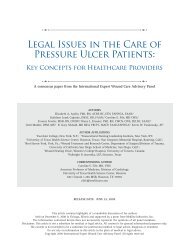2009 CAUTI guidelines - Centers for Disease Control and Prevention
2009 CAUTI guidelines - Centers for Disease Control and Prevention
2009 CAUTI guidelines - Centers for Disease Control and Prevention
You also want an ePaper? Increase the reach of your titles
YUMPU automatically turns print PDFs into web optimized ePapers that Google loves.
VI. Scope <strong>and</strong> PurposeThis guideline updates <strong>and</strong> exp<strong>and</strong>s the original CDC Guideline <strong>for</strong> <strong>Prevention</strong> of <strong>CAUTI</strong>published in 1981. The revised guideline addresses the prevention of <strong>CAUTI</strong> <strong>for</strong> patients inneed of either short- or long-term (i.e., > 30 days) urinary catheterization in any type ofhealthcare facility <strong>and</strong> evaluates evidence <strong>for</strong> alternative methods of urinary drainage, includingintermittent catheterization, external catheters, <strong>and</strong> suprapubic catheters. The guideline alsoincludes specific recommendations <strong>for</strong> implementation, per<strong>for</strong>mance measurement, <strong>and</strong>surveillance. Recommendations <strong>for</strong> further research are also provided to address theknowledge gaps in <strong>CAUTI</strong> prevention identified during the literature review.To evaluate the evidence on preventing <strong>CAUTI</strong>, we examined data addressing three keyquestions <strong>and</strong> related subquestions:1. Who should receive urinary catheters?A. When is urinary catheterization necessary?B. What are the risk factors <strong>for</strong> <strong>CAUTI</strong>?C. What populations are at highest risk of mortality from catheters?2. For those who may require urinary catheters, what are the best practices?Specifically, what are the risks <strong>and</strong> benefits associated with:A. Different approaches to catheterization?B. Different catheters or collecting systems?C. Different catheter management techniques?D. Different systems interventions (i.e., quality improvement programs)?3. What are the best practices <strong>for</strong> preventing UTI associated with obstructed urinarycatheters?This document is intended <strong>for</strong> use by infection prevention staff, healthcare epidemiologists,healthcare administrators, nurses, other healthcare providers, <strong>and</strong> persons responsible <strong>for</strong>developing, implementing, <strong>and</strong> evaluating infection prevention <strong>and</strong> control programs <strong>for</strong>healthcare settings across the continuum of care. The guideline can also be used as a resource<strong>for</strong> societies or organizations that wish to develop more detailed implementation guidance <strong>for</strong>prevention of <strong>CAUTI</strong>.25
















